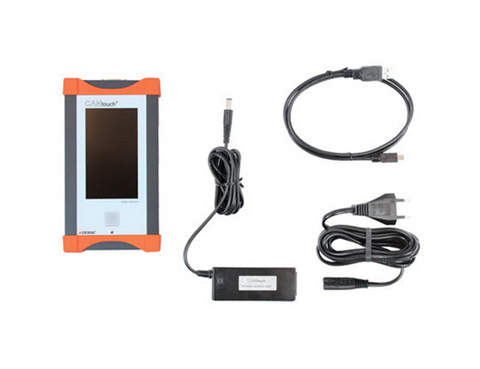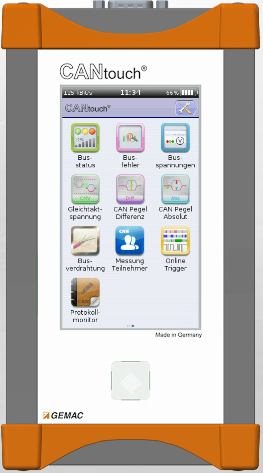CANtouch basic set
by GEMAC
Regular price£3,759.94 Sale price Pricing excludes VAT.Shipping cost calculated in checkout.
Notice:
Some of our products are on varied lead times, For confirmation on when you can expect your order to arrive, please call in and speak to one of our experts.
Our team are available from 9:00am - 5:00pm on +44(0) 1234 247 176 and will be happy to discuss any questions.
Queries and Shipping
If you’re unsure which product is right for your project, our team is here to help.
Use the chat bubble below, or call us 9am-5pm on +44 (0) 1234 247176 for advice.
Shipping: Some products have varied lead times. For exact delivery estimates and shipping costs, add the item to your basket and proceed to checkout, or call our team for confirmation.
| Languages: | German, Englisch |
| Bus systems: | CAN (ISO11898‑2), CANopen (CiA301), DeviceNet (EN 50325 – 2), SAE J1939 |
| Bit sampling : | 64-fold, 10240 sampling points |
| Bit timing: | Adjustable BTL cycles (tq), sample point and resynchronization jump width (SJW) |
| Supported baud rates | Depending on bus system: 10; 20; 50; 100; 125; 250; 500; 800; 1000 kbit/s |
| Additionally user-defined: 5; 33.3; 62.5; 75; 83.3; 200 kbit/s | |
| Automatic detection via baud rate scan, bit timing adjustable | |
| Bus status | Bus traffic detection (display: dominant, recessive, not defined, bus traffic) |
| Display of the Bus traffic load (0 … 100 %) | |
| characteristic, minimum and maximum value saving | |
| Bus errors | Display of detected frame errors |
| Distinction between active and passive error frames (0 … >50,000), trend chart | |
| Bus voltages | Display of the optional CAN supply voltage and shield voltage |
| Characteristic, minimum and maximum value saving | |
| Common mode voltage | Acquisition of the maximum voltage offset between the individual bus nodes |
| CAN level (absolute /differential) | Acquisition and evaluation of the differential and absolute CAN levels of all bus nodes during operation |
| Node measurement | Node related measurements |
| Quality value (signal quality), Disturbance-free voltage range, Edge steepness (falling and rising) and Oscilloscope display with message frame analysis |
|
| Online Trigger | Error analysis with adjustable values, variable time slices and trigger function |
| Protocol monitor | Send and receive of CAN messages |
Electrical parameters |
|
| Power supply and battery* | Integrated, rechargeable lithium-ion battery External power input: SELV d.c. voltage 14 V, internal fused with 2.5 A Operating with the supplied 35 W wide-range power supply unit only (SAW-14.0 – 2500) Times-to-empty: Standby: up to 500 hours Use: up to 36 hours Measuring: up to 6 hours Charge times: Quick charge to 80% in approx. 1 h Full charge in approx. 2 h |
| Potential difference between the CAN bus and USB connections | < 500 V AC |
| Voltage between any two terminals of the CAN connection or external ground, resp. | < ±30 V DC |
Measurements |
Range | Resolution | Accuracy (typ.) |
| Quality value | 0,0 % … 100,0 % | 0,1 % | - |
| Edge steepness | 0/64 … 64/64 | 1/64 | - |
| Disturbance-free voltage range | -0,75 V … +3,25 V | 0,05 V | 1,90 % ±100 mV |
| Measuring of the differential voltage | -0,75 V … +3,25 V | 0,01 V | 0,50 % ±10 mV (calibrated) |
| Measuring of the absolute voltage | -5,00 V … +10,00 V | 0,05 V | 0,50 % ±50 mV (calibrated) |
| Measuring of the shield voltage | -10,0 V … +1,0 V | 0,1 V | 0,25 % ±100 mV (calibrated) |
| Measuring of the CAN supply voltage | 0.0 V … 32,0 V | 0,1 V | 0,25 % ±100 mV (calibrated) |
| Measuring of the loop resistances | 0 Ω … 100 Ω 100 Ω … 1000 Ω |
0,1 Ω 1,0 Ω |
0,85 % ±0,2 Ω 0,85 % ±2,0 Ω |
| Measuring of the cable length | 2 m … 1000 m | 1 m | 5 % ±2 m (signal propagation delay: 4.5 ns/m) |
Mechanical parameters |
|
| Power supply unit connection | Extra-low voltage socket |
| CAN connection | 9‑pin D‑Sub connector |
| PC connection | Self-powered device to USB Specification 2.0, full speed, in addition, electrically isolated Connection of a drive for exchange of measuring data (USB mass storage device) |
| Housing | Aluminum housing, cover glass |
| Ambient conditions | Operation temperature: 5 °C … 40 °C Storage temperature: ‑20 °C … 60 °C Atmospheric humidity: 20 % … 80 %, non-condensing |
| Degree of protection of the housing | IP20 to EN 60529 |
| Dimensions | 186 mm x 102 mm x 37 mm |
| Weight | Approx. 860 g |


CANtouch Basic Set includes
- power supply (type: SAW-14.0 – 2500)
- power connection cable Euro
- USB cable
- 2 manuals (German, English)
The further development of the CAN-bus Tester 2 is battery-powered and equipped with a touch display. Its intuitive user interface allows extensive measurements to be taken in the shortest possible time. The results can be archived for documentation or later analysis and further processed on the PC.
The physical layer measurements have been extended to include the direct determination of potential differences between the participants (common mode/ground shift).
With the online trigger, you can monitor the bus for individual physical limits, determine problems over time and make errors visible in the oscillogram.
The protocol monitor is used for sending, receiving, decoding, and recording messages.
Explore our CAN-bus Testing & Diagnostics products
| Languages: | German, Englisch |
| Bus systems: | CAN (ISO11898‑2), CANopen (CiA301), DeviceNet (EN 50325 – 2), SAE J1939 |
| Bit sampling : | 64-fold, 10240 sampling points |
| Bit timing: | Adjustable BTL cycles (tq), sample point and resynchronization jump width (SJW) |
| Supported baud rates | Depending on bus system: 10; 20; 50; 100; 125; 250; 500; 800; 1000 kbit/s |
| Additionally user-defined: 5; 33.3; 62.5; 75; 83.3; 200 kbit/s | |
| Automatic detection via baud rate scan, bit timing adjustable | |
| Bus status | Bus traffic detection (display: dominant, recessive, not defined, bus traffic) |
| Display of the Bus traffic load (0 … 100 %) | |
| characteristic, minimum and maximum value saving | |
| Bus errors | Display of detected frame errors |
| Distinction between active and passive error frames (0 … >50,000), trend chart | |
| Bus voltages | Display of the optional CAN supply voltage and shield voltage |
| Characteristic, minimum and maximum value saving | |
| Common mode voltage | Acquisition of the maximum voltage offset between the individual bus nodes |
| CAN level (absolute /differential) | Acquisition and evaluation of the differential and absolute CAN levels of all bus nodes during operation |
| Node measurement | Node related measurements |
| Quality value (signal quality), Disturbance-free voltage range, Edge steepness (falling and rising) and Oscilloscope display with message frame analysis |
|
| Online Trigger | Error analysis with adjustable values, variable time slices and trigger function |
| Protocol monitor | Send and receive of CAN messages |
Electrical parameters |
|
| Power supply and battery* | Integrated, rechargeable lithium-ion battery External power input: SELV d.c. voltage 14 V, internal fused with 2.5 A Operating with the supplied 35 W wide-range power supply unit only (SAW-14.0 – 2500) Times-to-empty: Standby: up to 500 hours Use: up to 36 hours Measuring: up to 6 hours Charge times: Quick charge to 80% in approx. 1 h Full charge in approx. 2 h |
| Potential difference between the CAN bus and USB connections | < 500 V AC |
| Voltage between any two terminals of the CAN connection or external ground, resp. | < ±30 V DC |
Measurements |
Range | Resolution | Accuracy (typ.) |
| Quality value | 0,0 % … 100,0 % | 0,1 % | - |
| Edge steepness | 0/64 … 64/64 | 1/64 | - |
| Disturbance-free voltage range | -0,75 V … +3,25 V | 0,05 V | 1,90 % ±100 mV |
| Measuring of the differential voltage | -0,75 V … +3,25 V | 0,01 V | 0,50 % ±10 mV (calibrated) |
| Measuring of the absolute voltage | -5,00 V … +10,00 V | 0,05 V | 0,50 % ±50 mV (calibrated) |
| Measuring of the shield voltage | -10,0 V … +1,0 V | 0,1 V | 0,25 % ±100 mV (calibrated) |
| Measuring of the CAN supply voltage | 0.0 V … 32,0 V | 0,1 V | 0,25 % ±100 mV (calibrated) |
| Measuring of the loop resistances | 0 Ω … 100 Ω 100 Ω … 1000 Ω |
0,1 Ω 1,0 Ω |
0,85 % ±0,2 Ω 0,85 % ±2,0 Ω |
| Measuring of the cable length | 2 m … 1000 m | 1 m | 5 % ±2 m (signal propagation delay: 4.5 ns/m) |
Mechanical parameters |
|
| Power supply unit connection | Extra-low voltage socket |
| CAN connection | 9‑pin D‑Sub connector |
| PC connection | Self-powered device to USB Specification 2.0, full speed, in addition, electrically isolated Connection of a drive for exchange of measuring data (USB mass storage device) |
| Housing | Aluminum housing, cover glass |
| Ambient conditions | Operation temperature: 5 °C … 40 °C Storage temperature: ‑20 °C … 60 °C Atmospheric humidity: 20 % … 80 %, non-condensing |
| Degree of protection of the housing | IP20 to EN 60529 |
| Dimensions | 186 mm x 102 mm x 37 mm |
| Weight | Approx. 860 g |




